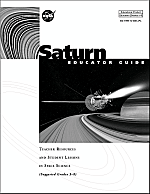Saturn Educator Guide
Successfully launched at 4:43 EDT on the morning of October 15, 1997, NASA's Cassini Mission to Saturn, is the most ambitious deep space mission ever. The Saturn Educator Guide enables this extraordinary mission to become a real-world motivational context for learning standards-based science in grades 5-8.
Overview of Guide Contents
- Lessons
Six standards-based, constructivist lessons.
- Enrichments
Relevant connections to art, poetry and mythology.
- Appendices
Questions and Answers: 101 questions posed as students would ask them
Glossary: Over 90 well-defined technical terms
Chart of Saturn's position in the sky over the course of the Cassini mission
Electromagnetic Spectrum
Educator Resources: References to books, WWW-sites, videos, CD-ROMS
Lesson Descriptions
Explore More!
For more information on the Cassini mission, visit the Cassini Web site. For more information and images of Saturn, check out JPL's Cassini Picture Archive.

